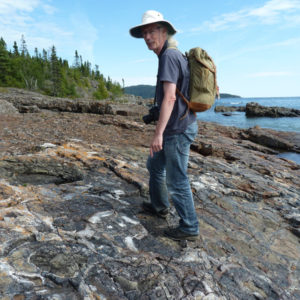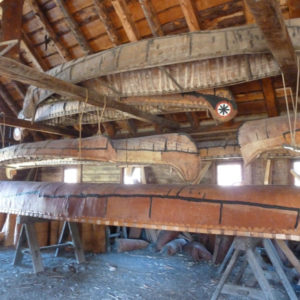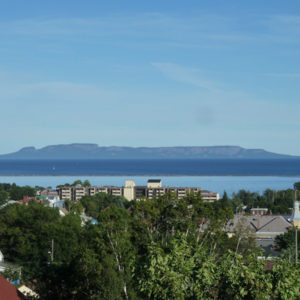Growing up on the Canadian Shield, my teachers would say we were living on the oldest rocks on the planet. Our glacier scarred hills were once mountains. To the west lay an ancient sea and to the north and east lay a great rift filled by Lake Superior and Lake Nipigon where great lava flows cap a jagged northshore landscape. Beyond this stand great rolling hills that were once in the massive magma chamber of an ancient volcano and are now captured for the world to see in paintings by the Group of Seven.
Once upon a time, when earth contained little life, there was a gentle sea. Now the violently fractured and glacier scraped landscape bears witness to the beginning of an explosion of life on earth – stromatolites. The blue green algae that produced earth’s first breathable atmosphere form columns of fossils called stromatolites. A visitor centre at Kakabeka Falls has polished cross sections to view.
Stromatolites are the oldest fossils on earth. This summer I sought them out in the wild with Hans on a hike to Schreiber Channel on the shore of Lake Superior. Before entering the woods, the rugged trail crossed a cobble beach with pools of water trapped in outcrops of bedrock hosting butterwort, twisted cedars, and tiny bluebells. Higher up were low spreading junipers and trailing mats of bearberry. The thick woods held ladyslipper orchids, ghostly white Indian Pipe, and sphagnum moss moist with yesterday’s rain.
The trail, advertised as “groomed”, was not. It was worse than 12 years ago but government funding provided a nice new parking area. Persisting through deadfalls and detours we made our way along the overgrown trail and the effort paid off as we crossed cobbled beaches of long ago when the land rose from the weight of the glaciers and left them stranded to grow over with lichens, birches and bearberry. It was wild and beautiful all the way to the channel. Next time I’d take a boat, but there were the famed stromatolites and we ate lunch sitting on them.
Thankfully, the rest of our trip involved real groomed trails in provincial parks. In Neys we explored the magma chamber and the great sand beach, one of the few suitable for swimming on Lake Superior because it is warmed by incoming river water.
Sleeping Giant Park was heavily populated by bears and we bought bear bells to avoid encounters. The park is known for its spectacular vistas and unusual arctic plant populations at the cool shoreline. At warmer and higher elevations on the Sleeping Giant (which is what the peninsula resembles when viewed from Thunder Bay), one can be surprised by clematis and poison ivy.
On our trip, Hans and I picked blueberries, hiked around, collected amethyst, and keeping an eye on business closing days and times, realized how much the area has to offer tourists and how little prepared it is for them. I teased Hans, “You need a local guide”. True. I knew the unnamed roads that led to the swimming places. GPS could not help there. I also knew we had to get up early if we wanted to be back in time for supper.
GPS was valuable for finding a route around the abandoned open pit iron mine outside Atikokan. It is being developed as a recreation area but many parts are marked as too dangerous to explore. Green waters rise yearly, flanked by the red pit walls, and swallow up the concentric circles of roads once travelled by monster Euclids loaded with iron ore. There is still interesting rockhounding possible if accompanied by a guide.
Tourism concentrates on hunting, fishing, and canoeing although there is much more to offer. My home town, formerly home to two large iron mines, takes its new role seriously. It is the gateway to Quetico Park, a wilderness park that will take you back to the days of the fur trade, once plied by the explorers who opened up and mapped Canada. To assure a wilderness experience, no airplanes are allowed to fly over and motor boats are not allowed. No wonder Atikokan is a Canoe Capital and our most famous recent ambassador, Mike Ranta, completed a cross-Canada canoe trip last year with his dog Spitzi.
The Atikokan High School has a popular Outers Programme that combines leadership training and wilderness skills. My son and I both took part in it and the reward is an 11-day trip through Quetico Park, planned and executed by the students. By then our experience should assure our survival 🙂 My memories of that trip and a spectacular aurora remain vivid.
Hospitality was top-notch. Canadians are friendly and happy to show you the way. If only Professor Snape (Alan Rickman) had asked, he would have known he was going the wrong way on the highway in the movie Snow Cake and he would have made it to Winnipeg where he was going instead of Wawa but then he would not have met Sigourney Weaver, which was the point of the story…
Anyway, us northerners are used to southern types showing up and getting it all wrong. We think it’s funny except when it hurts. Once upon a time our highways were plowed in winter. Now the contract is handled by an Australian company that doesn’t do it and happily pays the fine for not doing it so the contract must be lucrative enough.
Northerners live with being an afterthought. The little government office where I worked bore frequent witness to us being last to know. We famously found out on the radio about the spring bear hunt being cancelled and it seemed like an April Fool’s joke until we knew it was true.
Canadians around there don’t put up with nonsense either and they don’t care who you are. The owner of a historic hotel in Rossport proudly punched out Bob Seger and sent him on his way. So, you’ve got to be polite or else.
Do I miss Canada? Everyone asks. My home town always has a place in my heart. It is a little known jewel and it will welcome and challenge you with memories to last a lifetime. Just ask Bud and Sandy Dickson at Canoe Canada Outfitters or Barry Brown at Clearwater West Lodge!
 +31 (0)50 367 71 97
+31 (0)50 367 71 97  info@connect-int.org
info@connect-int.org





